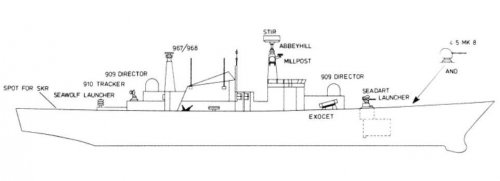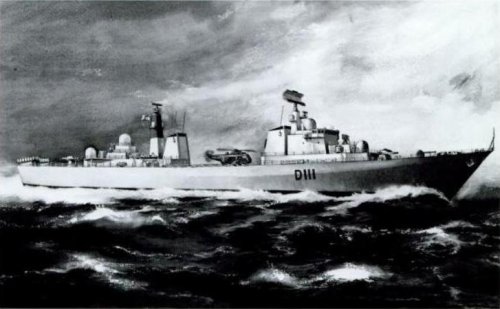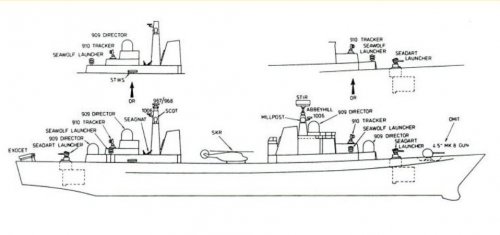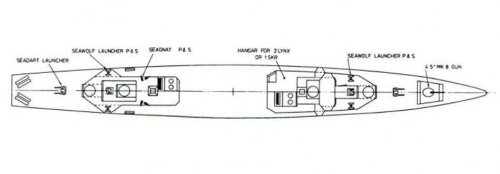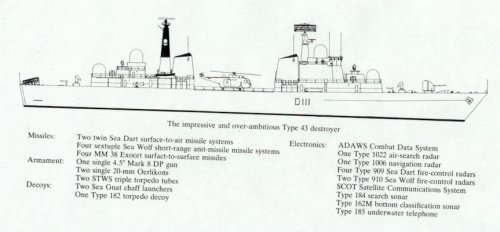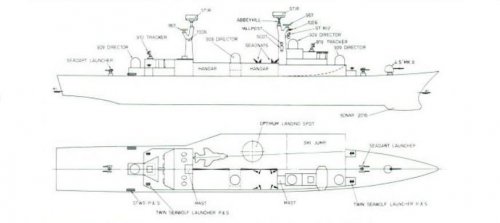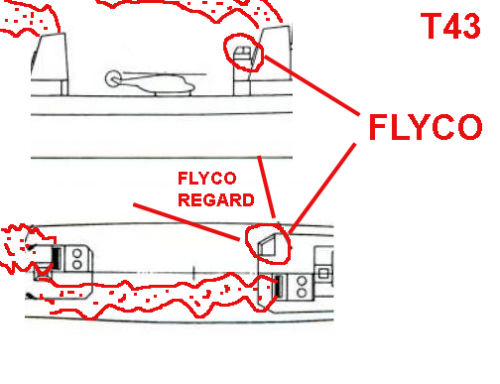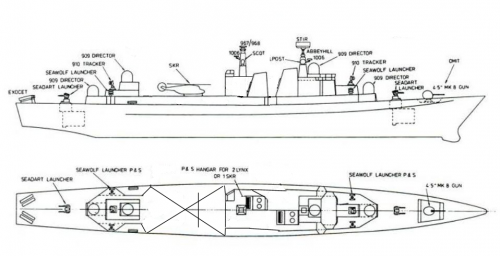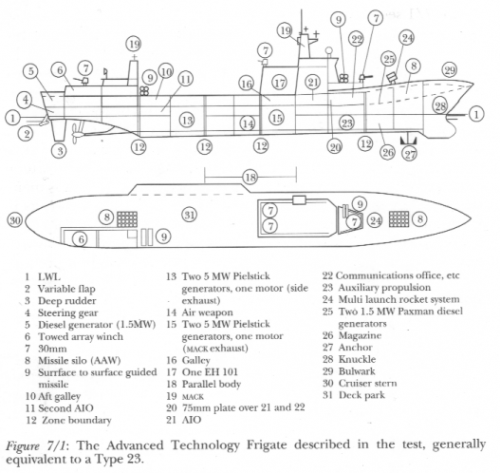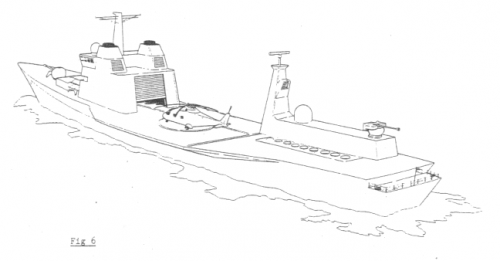You are using an out of date browser. It may not display this or other websites correctly.
You should upgrade or use an alternative browser.
You should upgrade or use an alternative browser.
British Type 43 destroyer
- Thread starter PMN1
- Start date
- Joined
- 3 January 2006
- Messages
- 1,223
- Reaction score
- 943
PMN1 said:This design was a double ended design with Sea Dart and Sea Wolf launchers fore and aft and the helicopter deck amidships.
Did any other country look at amidships helicopter decks?
South Africa gave the converted tanker Tafelberg an amidships flight deck, complete with a double hangar with the doors facing forward.
Line drawing of small Type 43 destroyer, an updated Type 42 with Sea Dart Mk II.
According to Rebuilding the Royal Navy: Warship Design Since 1945 by David K. Brown and George Moore, Chatham Publishing/Naval Institute Press, 2003:
http://books.google.com/books?id=BivKTPcx3woC&printsec=frontcover&source=gbs_v2_summary_r&cad=0#v=onepage&q=&f=false
According to Rebuilding the Royal Navy: Warship Design Since 1945 by David K. Brown and George Moore, Chatham Publishing/Naval Institute Press, 2003:
Simulations showed it had little capability.
http://books.google.com/books?id=BivKTPcx3woC&printsec=frontcover&source=gbs_v2_summary_r&cad=0#v=onepage&q=&f=false
Attachments
Artist impression and line drawing of the "big variant" Type 43 destroyer.
According to Rebuilding the Royal Navy: Warship Design Since 1945 by David K. Brown and George Moore, Chatham Publishing/Naval Institute Press, 2003:
According to Rebuilding the Royal Navy: Warship Design Since 1945 by David K. Brown and George Moore, Chatham Publishing/Naval Institute Press, 2003:
...which seemed much more cost effective than a larger number of smaller ships. The big gap amidships was intended to operate a Merlin [sic] helicopter, and the aesthetic treatment owed much to the pre-war Southampton class cruisers.
Attachments
Version of the Type 43 designed to carry two Harriers.
According to Rebuilding the Royal Navy: Warship Design Since 1945 by David K. Brown and George Moore, Chatham Publishing/Naval Institute Press, 2003:
According to Rebuilding the Royal Navy: Warship Design Since 1945 by David K. Brown and George Moore, Chatham Publishing/Naval Institute Press, 2003:
It proved to not be worth the effort. Many studies are carried out to investigate the impact of even unlikely requirements.
Attachments
- Joined
- 18 March 2008
- Messages
- 3,529
- Reaction score
- 983
Longshaor said:What stikes me with this design is, even with something like the US RAST system or the Canadian Bear Trap, how safe would it really be to try to land a Sea King size helicopter amidships in bad weather?
Safer than anywhere else. Having the flight deck as close to amidships significantly improves the ability to land in heavy seas. As the vessel pitches up and down the aft flight deck moves up and down and a helicopter needs to be winched down (RAST/Bear Trap) or match this ascending and descending flight deck or be bounced off... With the flight deck amidships at the centre of the ship's pitching movement it remains relatively steady. The helicopter can approach from the beam or quarter so the aft superstructure is not in the way of its flight path.
Just call me Ray
ACCESS: Top Secret
- Joined
- 26 August 2007
- Messages
- 672
- Reaction score
- 55
The only problem is that the superstructure now creates dangerous turbulence from the helicopter's own rotor wash, a reason why this hasn't been widely adopted now.
- Joined
- 18 March 2008
- Messages
- 3,529
- Reaction score
- 983
Just call me Ray said:The only problem is that the superstructure now creates dangerous turbulence from the helicopter's own rotor wash, a reason why this hasn't been widely adopted now.
Unless the ship is flush decked there will be turbulence from the superstructure no matter where the flight deck is located. Because helicopters approach at such low relative speeds to the ship the burble is not that significant. Certainly no where near the importance of flight deck vertical movement.
Amidships flight decks can be found in such ships as the CG 47s. The only reason most ships have aft flight decks is because it’s much easier to design and build them that way. The FFG 7 was originally going to have an amidships flight deck but when the design requirement was changed from one to two LAMPS helos it was moved aft for more hangar width.
Ray said
That's clearly not the only problem. The helicopter must match the ship's forward movement more accurately for longer than with an aft deck, while sliding in between the funnels; there is a much narrower angle of escape if a misjudgement is made. Even without turbulence, it must be more hazardous to land between two funnels than to land on an open space behind one. A direct approach from behind, slowing to match the speed of the ship, is not possible. Nor is any approach free from some interference from hot funnel gases.The only problem is that the superstructure now creates dangerous turbulence from the helicopter's own rotor wash,
- Joined
- 16 April 2008
- Messages
- 9,605
- Reaction score
- 14,502
Abraham Gubler said:Amidships flight decks can be found in such ships as the CG 47s. The only reason most ships have aft flight decks is because it’s much easier to design and build them that way. The FFG 7 was originally going to have an amidships flight deck but when the design requirement was changed from one to two LAMPS helos it was moved aft for more hangar width.
There's quite a difference between "midships" flight decks where there is no superstructure aft of the flight deck and flight decks sandwiched between two deckhouses.
PS: I've seen the early sketches of the Patrol Frigate before it morphed into FFG-7, and the flight deck was nowhere close to midships. There was a section of flat weather deck aft of the flight deck but the center of the landing spot was still at about 80% of waterline length. That's much further aft than in the DD-963 and CG-47 designs.
Just call me Ray
ACCESS: Top Secret
- Joined
- 26 August 2007
- Messages
- 672
- Reaction score
- 55
Abraham Gubler said:Amidships flight decks can be found in such ships as the CG 47s. T
http://www.combatindex.com/store/3D/Sample/cg47_port_plan_01.jpg
Uhhh it looks pretty aft to me.
- Joined
- 18 March 2008
- Messages
- 3,529
- Reaction score
- 983
Smurf, TomS, Ray: a semantic debate with a group of people I can safely assume have had no actual, practical and professional contact with the naval helicopter community is not my idea of a fun way to spend the weekend. If you doubt me then I guess none of you have had the benefit of spending several days at a naval helicopter conference surrounded by said professionals and their constant focus on deck pitch. Nor have had the ‘fun’ of landing on even a slightly pitching deck in a Sea King helicopter.
In the real world the positioning of the Type 43’s flight deck presents very little superstructure obstruction for naval helicopters. The flight approach from the side is the same as used for landing on light carriers so hardly a shortfall. The worst thing about this deck is its low height above the waterline meaning it will probably have more sea spray to contend with. The advantage of the amidships position for reducing pitching movement is considerable.
In the real world the positioning of the Type 43’s flight deck presents very little superstructure obstruction for naval helicopters. The flight approach from the side is the same as used for landing on light carriers so hardly a shortfall. The worst thing about this deck is its low height above the waterline meaning it will probably have more sea spray to contend with. The advantage of the amidships position for reducing pitching movement is considerable.
IMHO the best aviation facilities on a "conventional" escort are on the Canadian Iroquois class:
http://en.wikipedia.org/wiki/File:HMCS_Iroquois_DDH_280.jpg
The flight deck is as close to amidships as possible and the hanger is virtually there. This IMO would ease the handling of the SK after landing I would it is no mean feat dealing with such a large aircraft in heavy weather.
I have never understood why the Canadians didn't evolve this design into what became the Halifax class and retained the two helo configuration which I feel is a major loss. This opinion extends to the T23, T45, Horizon Class, et al. In peace time one helo can be carried two when things Hot Up.
With regard to the T43, I remember first seeing an image of it in Leo Marriots British Destroyers, and being total amazed at the configuration. I dread to think what attrition rates on FAA crews would have been. IMO it is one of the ugliest warships designs produced.
http://en.wikipedia.org/wiki/File:HMCS_Iroquois_DDH_280.jpg
The flight deck is as close to amidships as possible and the hanger is virtually there. This IMO would ease the handling of the SK after landing I would it is no mean feat dealing with such a large aircraft in heavy weather.
I have never understood why the Canadians didn't evolve this design into what became the Halifax class and retained the two helo configuration which I feel is a major loss. This opinion extends to the T23, T45, Horizon Class, et al. In peace time one helo can be carried two when things Hot Up.
With regard to the T43, I remember first seeing an image of it in Leo Marriots British Destroyers, and being total amazed at the configuration. I dread to think what attrition rates on FAA crews would have been. IMO it is one of the ugliest warships designs produced.
Abraham Gubler said:Smurf, TomS, Ray: a semantic debate with a group of people I can safely assume have had no actual, practical and professional contact with the naval helicopter community is not my idea of a fun way to spend the weekend. If you doubt me then I guess none of you have had the benefit of spending several days at a naval helicopter conference surrounded by said professionals and their constant focus on deck pitch. Nor have had the ‘fun’ of landing on even a slightly pitching deck in a Sea King helicopter.
In the real world the positioning of the Type 43’s flight deck presents very little superstructure obstruction for naval helicopters. The flight approach from the side is the same as used for landing on light carriers so hardly a shortfall. The worst thing about this deck is its low height above the waterline meaning it will probably have more sea spray to contend with. The advantage of the amidships position for reducing pitching movement is considerable.
Thank you very much for the information and your participation Abraham.
Longshaor
ACCESS: Restricted
- Joined
- 1 October 2006
- Messages
- 37
- Reaction score
- 6
Abraham,
I'm sorry if my question got your feather ruffled, that wasn't my intent. My only knowledge of helo ops at sea came from the son of a friend of mine who was an ASW systems operator/rescue swimmer with HSL-43. Back then I was a docent on the USS New Jersey when she first opened as a museum and had a few questions for him regarding helo ops from the ship.
I was a naval architecture/marine engineering major (back when dinosaurs roamed the earth) and concur with your point that the closer you are to a ship's center of movement the less movement there will be to contend with. I asked the question because, to me, trying to land between what could be called a pair of moving four-story buildings seemed pretty hairy.
If you don't mind my asking, you stated that the flight approach for a Type 43 would be the same as that used on light carriers. Could you describe that in a little more detail please?
Thanks in advance!
I'm sorry if my question got your feather ruffled, that wasn't my intent. My only knowledge of helo ops at sea came from the son of a friend of mine who was an ASW systems operator/rescue swimmer with HSL-43. Back then I was a docent on the USS New Jersey when she first opened as a museum and had a few questions for him regarding helo ops from the ship.
I was a naval architecture/marine engineering major (back when dinosaurs roamed the earth) and concur with your point that the closer you are to a ship's center of movement the less movement there will be to contend with. I asked the question because, to me, trying to land between what could be called a pair of moving four-story buildings seemed pretty hairy.
If you don't mind my asking, you stated that the flight approach for a Type 43 would be the same as that used on light carriers. Could you describe that in a little more detail please?
Thanks in advance!
- Joined
- 18 March 2008
- Messages
- 3,529
- Reaction score
- 983
Dear Longshar: Your question has in no way has ruffled my feathers. What got me upset was those OTHER posters who chimed in to decry anything against the conventional wisdom of accumulated readers of Wings magazine...
Landing on any non-carrier flight deck in a helicopter requires precision flying. Even if there is only one wall (aft deck) to worry about that is one vertical surface more than the number that you can safely fly your helicopter into. As any other structures on a ship is likely to be moving in the same direction and retaining the same distance from each other there is no need to be ‘twice’ as precise as your approach to the single structure. As long as you maintain the right clearance from the wall in front you won't hit the wall behind. Certainly in a sea state where the ship is pitching worrying about the wall behind you in addition to the wall in front of you is a small price to pay for a deck that is NOT going up and down by 20-30 feet...
If we have another look at the flight deck area of the Type 43 the helicopter flight path becomes quite evident. The ship’s FLYCO (aka control tower) is mounted on the port with clear fields of regard to port. Also the positioning of the forward and aft offset stacks means on the port side there is a clear avenue through the hot gas to the amidships flight deck.
This would indicate the flight path for landing on helicopters is up alongside the ship port side, match ship’s speed beside the flight deck, then come across to starboard until above the landing spot and then hover down to the deck. This is the same flight path as SHARs and SKs onto the decks of Invincible class carriers. When the sea is rough and the Invincible is pitching up and down they do so at right amidships. Why an Invincible can maintain a CAP in weather in which Nimitzes are running for lee shores.
Also worthwhile to note is the extreme length of what appears to be a hull knuckle on the Type 43. It extends ¾ the length of the ship. Such a knuckle would be needed to reduce the amount of spray up on the main deck level, amidships flight deck.
The Royal Navy knows an awful lot about flight operations in rough weather from carriers and frigates. Cost cutting and good enough philosophises has lead to the aft flight deck on the Type 24 and Type 45s. But like the RCN and back in the old days of the GIUK gap they did from time to time plan to build a ship that can operate helicopters in extreme sea conditions.
Landing on any non-carrier flight deck in a helicopter requires precision flying. Even if there is only one wall (aft deck) to worry about that is one vertical surface more than the number that you can safely fly your helicopter into. As any other structures on a ship is likely to be moving in the same direction and retaining the same distance from each other there is no need to be ‘twice’ as precise as your approach to the single structure. As long as you maintain the right clearance from the wall in front you won't hit the wall behind. Certainly in a sea state where the ship is pitching worrying about the wall behind you in addition to the wall in front of you is a small price to pay for a deck that is NOT going up and down by 20-30 feet...
If we have another look at the flight deck area of the Type 43 the helicopter flight path becomes quite evident. The ship’s FLYCO (aka control tower) is mounted on the port with clear fields of regard to port. Also the positioning of the forward and aft offset stacks means on the port side there is a clear avenue through the hot gas to the amidships flight deck.
This would indicate the flight path for landing on helicopters is up alongside the ship port side, match ship’s speed beside the flight deck, then come across to starboard until above the landing spot and then hover down to the deck. This is the same flight path as SHARs and SKs onto the decks of Invincible class carriers. When the sea is rough and the Invincible is pitching up and down they do so at right amidships. Why an Invincible can maintain a CAP in weather in which Nimitzes are running for lee shores.
Also worthwhile to note is the extreme length of what appears to be a hull knuckle on the Type 43. It extends ¾ the length of the ship. Such a knuckle would be needed to reduce the amount of spray up on the main deck level, amidships flight deck.
The Royal Navy knows an awful lot about flight operations in rough weather from carriers and frigates. Cost cutting and good enough philosophises has lead to the aft flight deck on the Type 24 and Type 45s. But like the RCN and back in the old days of the GIUK gap they did from time to time plan to build a ship that can operate helicopters in extreme sea conditions.
Attachments
- Joined
- 5 May 2007
- Messages
- 1,483
- Reaction score
- 2,859
Abraham Gubler said:This would indicate the flight path for landing on helicopters is up alongside the ship port side, match ship’s speed beside the flight deck, then come across to starboard until above the landing spot and then hover down to the deck. This is the same flight path as SHARs and SKs onto the decks of Invincible class carriers. When the sea is rough and the Invincible is pitching up and down they do so at right amidships. Why an Invincible can maintain a CAP in weather in which Nimitzes are running for lee shores.
It should be noted that RN operating procedures call for that approach path all the time, even on surface combatants with aft flight decks. Probably again comes from the requirement to operate in the GIUK gap in February...
At the risk of being shouted at...
It's worth noting that when landing a pair of double-decker buses (i.e. a Merlin) on a Type 23 there's not that much space behind the helicopter anyway:
http://admin.royalnavy.mod.uk/operations-and-support/fleet-air-arm/fly-navy-100/modern-gallery/merlin/*/changeNav/00h00100200l004006/imageIndex/8/outputFormat/html/
Oh, and yes, turbulence *can* be an issue - but it depends on the design of the superstructure. That's why so much effort is being put into the SAIF system for improving simulator based training (which uses detailed CFD modeling to produce simulators that reflect the actual ship).
http://www.sea.co.uk/docs/cs_po_saif.pdf
This might have become an issue for a T43 operating at some bearings relative to the wind, but when head-on it might not have been different to a conventional arrangement.
The two things I do wonder about are (1) If a landing is aborted, would a pilot ever slide aft, or is the SOP always to break off to one side (port, I assume), and (2) SKR - the Sea King Replacement, was slightly smaller than the eventual Merlin. A T43 type arrangement might not be as good at accommodating growth in the helicopter size compared to, say the improved arrangement suggested by DKB for his double-ended Type 23 equivalent.
RP1
[Edited for SPAG]
It's worth noting that when landing a pair of double-decker buses (i.e. a Merlin) on a Type 23 there's not that much space behind the helicopter anyway:
http://admin.royalnavy.mod.uk/operations-and-support/fleet-air-arm/fly-navy-100/modern-gallery/merlin/*/changeNav/00h00100200l004006/imageIndex/8/outputFormat/html/
Oh, and yes, turbulence *can* be an issue - but it depends on the design of the superstructure. That's why so much effort is being put into the SAIF system for improving simulator based training (which uses detailed CFD modeling to produce simulators that reflect the actual ship).
http://www.sea.co.uk/docs/cs_po_saif.pdf
This might have become an issue for a T43 operating at some bearings relative to the wind, but when head-on it might not have been different to a conventional arrangement.
The two things I do wonder about are (1) If a landing is aborted, would a pilot ever slide aft, or is the SOP always to break off to one side (port, I assume), and (2) SKR - the Sea King Replacement, was slightly smaller than the eventual Merlin. A T43 type arrangement might not be as good at accommodating growth in the helicopter size compared to, say the improved arrangement suggested by DKB for his double-ended Type 23 equivalent.
RP1
[Edited for SPAG]
Brown says the airmen initially didn't like the idea of the amidships flight deck but a compromise was reached.
Interestingly in his book 'The Future British Surface Fleet' Brown describes and has a drawing of 'The Advanced Technology Frigate' designed around the Type 23 role.
This had a similar arrangement with the flight deck more or less amidships sponsoned out to port, the normal direction of approach, while the aft superstructure is in the form of a small carrier style island to starboard.
It was designed to 'fight hurt' with a 20 cell SAM VLS, a quad SSM launcher and 30mm guns fore and aft plus a MLRS?? forward and additional 30mm amidships on top of the hanger.
Not sure from the drawing if the aft VLS which is alongside the aft 'island' is flush with the deck or not.
Doesn't say much on size except that it would be bigger than a Type 23.
Interestingly in his book 'The Future British Surface Fleet' Brown describes and has a drawing of 'The Advanced Technology Frigate' designed around the Type 23 role.
This had a similar arrangement with the flight deck more or less amidships sponsoned out to port, the normal direction of approach, while the aft superstructure is in the form of a small carrier style island to starboard.
It was designed to 'fight hurt' with a 20 cell SAM VLS, a quad SSM launcher and 30mm guns fore and aft plus a MLRS?? forward and additional 30mm amidships on top of the hanger.
Not sure from the drawing if the aft VLS which is alongside the aft 'island' is flush with the deck or not.
Doesn't say much on size except that it would be bigger than a Type 23.
Abraham Gubler said:Dear Longshar: Your question has in no way has ruffled my feathers. What got me upset was those OTHER posters who chimed in to decry anything against the conventional wisdom of accumulated readers of Wings magazine...
Landing on any non-carrier flight deck in a helicopter requires precision flying. Even if there is only one wall (aft deck) to worry about that is one vertical surface more than the number that you can safely fly your helicopter into. As any other structures on a ship is likely to be moving in the same direction and retaining the same distance from each other there is no need to be ‘twice’ as precise as your approach to the single structure. As long as you maintain the right clearance from the wall in front you won't hit the wall behind. Certainly in a sea state where the ship is pitching worrying about the wall behind you in addition to the wall in front of you is a small price to pay for a deck that is NOT going up and down by 20-30 feet...
If we have another look at the flight deck area of the Type 43 the helicopter flight path becomes quite evident. The ship’s FLYCO (aka control tower) is mounted on the port with clear fields of regard to port. Also the positioning of the forward and aft offset stacks means on the port side there is a clear avenue through the hot gas to the amidships flight deck.
This would indicate the flight path for landing on helicopters is up alongside the ship port side, match ship’s speed beside the flight deck, then come across to starboard until above the landing spot and then hover down to the deck. This is the same flight path as SHARs and SKs onto the decks of Invincible class carriers. When the sea is rough and the Invincible is pitching up and down they do so at right amidships. Why an Invincible can maintain a CAP in weather in which Nimitzes are running for lee shores.
Also worthwhile to note is the extreme length of what appears to be a hull knuckle on the Type 43. It extends ¾ the length of the ship. Such a knuckle would be needed to reduce the amount of spray up on the main deck level, amidships flight deck.
The Royal Navy knows an awful lot about flight operations in rough weather from carriers and frigates. Cost cutting and good enough philosophises has lead to the aft flight deck on the Type 24 and Type 45s. But like the RCN and back in the old days of the GIUK gap they did from time to time plan to build a ship that can operate helicopters in extreme sea conditions.
Thank you very much for taking the time for writing an explanation. Very interesting.
- Joined
- 18 March 2008
- Messages
- 3,529
- Reaction score
- 983
RP1 said:A T43 type arrangement might not be as good at accommodating growth in the helicopter size compared to, say the improved arrangement suggested by DKB for his double-ended Type 23 equivalent.
If you could link to that design (double ended T23) that would be nice.
Interesting to look at design alternatives to the T43 like a more 'accessible' DD 963 type flight deck (see attach) and you retain access problems with the aft Type 909 houses you increase your burble with a bigger superstructure forward of the flight deck and you place all the exhaust into the flight path of the helicopter. Not to mention having to combine your separated engine rooms into a single area.
Interestingly the solution to much of this is in the Sea Dart missile. And in particular the cancelled block II that was to have TVC on its booster and ICWI homing for the seeker. This would enable the launcher to be displaced from the Type 909 directors. Much like on CG 47s and DDG 51s with the SM-2 missile and AEGIS. But even with the new missile the T43 would have to sacrifice unit propulsion on its length to ‘free’ up the rear access to the flight deck.
Attachments
If you could link to that design (double ended T23) that would be nice.
The design was described in "The Future British Surface Fleet" and also in a RINA Warships Conference paper, about 1991 or thereabouts.
If you'll excuse the use of Shipbucket, I don't have the originals to hand:

[Ninja Edit: Originals attached!]
The flight deck is offset to port with a small sponson (structural only - it's too small to contain anything). The aft superstructure is offset to starboard and is just wide enough to take the Sea Wolf FCR and 30mm (which was the naval RARDEN mount in some versions of the design). The aft VLSW silos are mounted in the deck inboard of the aft superstructure (roughly on the centreline) and clear of the flight deck. Hangar between the fwd funnels and split diesel-electric, split ops room, split accommodation and auxiliaries architecture.
RP1
Attachments
- Joined
- 18 March 2008
- Messages
- 3,529
- Reaction score
- 983
RP1 said:The flight deck is offset to port with a small sponson (structural only - it's too small to contain anything). The aft superstructure is offset to starboard and is just wide enough to take the Sea Wolf FCR and 30mm (which was the naval RARDEN mount in some versions of the design). The aft VLSW silos are mounted in the deck inboard of the aft superstructure (roughly on the centreline) and clear of the flight deck. Hangar between the fwd funnels and split diesel-electric, split ops room, split accommodation and auxiliaries architecture.
That's interesting stuff. With the overhanging flight deck I wonder if that frees up space for a deck park to starboard?
- Joined
- 29 September 2006
- Messages
- 1,794
- Reaction score
- 1,360
That's a very interesting design RP1.
What was the stated displacement?
What was the stated displacement?
Abraham Gubler said:RP1 said:A T43 type arrangement might not be as good at accommodating growth in the helicopter size compared to, say the improved arrangement suggested by DKB for his double-ended Type 23 equivalent.
If you could link to that design (double ended T23) that would be nice.
Interesting to look at design alternatives to the T43 like a more 'accessible' DD 963 type flight deck (see attach) and you retain access problems with the aft Type 909 houses you increase your burble with a bigger superstructure forward of the flight deck and you place all the exhaust into the flight path of the helicopter. Not to mention having to combine your separated engine rooms into a single area.
Interestingly the solution to much of this is in the Sea Dart missile. And in particular the cancelled block II that was to have TVC on its booster and ICWI homing for the seeker. This would enable the launcher to be displaced from the Type 909 directors. Much like on CG 47s and DDG 51s with the SM-2 missile and AEGIS. But even with the new missile the T43 would have to sacrifice unit propulsion on its length to ‘free’ up the rear access to the flight deck.
Four questions:
Not being funny but Burble? Is that a technical term or a typo never seen it applied like this before?
ICWI? What is that an acronym for, I believe the CW is Continuous Wave, what are the two I's?
When you say that the Block II missile would allow displacement of the Type 909 from the launcher. Bearing in mind that on all the Sea Dart equipped ships the launcher was anything from around 200 to 400 feet from the secondary director, what do you mean by your statement.
Final question, in the actual Sea Dart ships, what was the procedure for the use of the after director. The second director was used so that two targets could be engaged at once, if the foward launcher had illuminated one target, and the aft one was illuminating a second, if two missiles had been launched how would it differentiate between the two returns. Also if a target was approaching from directly astern, how would a missile be gathered onto the target?
Regards.
RP1 said:If you could link to that design (double ended T23) that would be nice.
The design was described in "The Future British Surface Fleet" and also in a RINA Warships Conference paper, about 1991 or thereabouts.
If you'll excuse the use of Shipbucket, I don't have the originals to hand:
The Future British Surface Fleet doesn't say why a MLRS rather than a gun, did the RINA Conference paper?
JohnR:
http://en.wiktionary.org/wiki/burble
IIRC in this case it is the "blob" of turbulence behind the superstructure. An interesting paper was presented at this years RINA Warships conference on how to reduce this.
ICWI = Interrupted Continuous Wave Illumination. i.e. that provided by phased arrays (e.g. APAR) or a CW illuminator rapidly switching between two targets.
Published comments on Sea Dart's performance in the 1991 Gulf War imply that the arc of fire was severely limited by this problem, prior to the fitting of a better auto-pilot to the missile in the 1980s - but that's just an implication. Remember that, as Friedman notes, Sea Dart was originally designed for operations in a low threat environment.
RP1
http://en.wiktionary.org/wiki/burble
The turbulent boundary layer about a moving streamlined body.
IIRC in this case it is the "blob" of turbulence behind the superstructure. An interesting paper was presented at this years RINA Warships conference on how to reduce this.
ICWI = Interrupted Continuous Wave Illumination. i.e. that provided by phased arrays (e.g. APAR) or a CW illuminator rapidly switching between two targets.
Also if a target was approaching from directly astern, how would a missile be gathered onto the target?
Published comments on Sea Dart's performance in the 1991 Gulf War imply that the arc of fire was severely limited by this problem, prior to the fitting of a better auto-pilot to the missile in the 1980s - but that's just an implication. Remember that, as Friedman notes, Sea Dart was originally designed for operations in a low threat environment.
RP1
- Joined
- 27 December 2005
- Messages
- 17,748
- Reaction score
- 26,421
Off-topic posts removed.
Of course anyone can participate in a discussion, even in a subject they don't know that well. However, one should always be wary of making unsupported claims. There is a big difference between posting "Wouldn't the superstructure create dangerous turbulence from the helicopter's own rotor wash?" and posting "The only problem is that the superstructure now creates dangerous turbulence from the helicopter's own rotor wash, a reason why this hasn't been widely adopted now."
The first, anyone can post and nobody would have the slightest problem with. The second implies detailed personal knowledge of the subject, allowing the user to make a definitive statement of fact. When someone then disagreed with the statement, the response was to question that other person's credentials. That isn't correct behaviour.
Its easy to pontificate online on subjects one has only sketchy knowledge of, but it rarely makes for interesting discussions. Hence why I stress the importance of quoting sources for facts wherever possible.
Of course anyone can participate in a discussion, even in a subject they don't know that well. However, one should always be wary of making unsupported claims. There is a big difference between posting "Wouldn't the superstructure create dangerous turbulence from the helicopter's own rotor wash?" and posting "The only problem is that the superstructure now creates dangerous turbulence from the helicopter's own rotor wash, a reason why this hasn't been widely adopted now."
The first, anyone can post and nobody would have the slightest problem with. The second implies detailed personal knowledge of the subject, allowing the user to make a definitive statement of fact. When someone then disagreed with the statement, the response was to question that other person's credentials. That isn't correct behaviour.
Its easy to pontificate online on subjects one has only sketchy knowledge of, but it rarely makes for interesting discussions. Hence why I stress the importance of quoting sources for facts wherever possible.
- Joined
- 16 April 2008
- Messages
- 9,605
- Reaction score
- 14,502
I've been re-reading this. I'm sorry if I overreacted, but I still feel that Ahraham's response was quite condescending. I have no problem being told I'm wrong and why, but being told that I'm not worthy someone's time is a bit over the top.
Now, just to explain where I was coming from more clearly, some years ago, I showed this design to acquaintances of mine with USN helicopter experience, and they thought it was very dangerous-looking. But from what has been said in this thread, it sounds like some of that may be down to differences in operating techniques. My impression is that the USN doesn't fly landings the same way as the RN or RAN -- that a 45-degree angled approach is the norm, rather than matching speed and sliding in sideways as Abraham describes. If that impression is correct, that would explain why two groups of pilots might reach very different conclusions about safety of the design.
I'll stick to my statement that the 1970s Patrol Frigate did not have a midships pad -- even in the early versions, the pad was only twenty or thirty feet forward of the stern, well aft of what a naval architect would call amidships.
Now, just to explain where I was coming from more clearly, some years ago, I showed this design to acquaintances of mine with USN helicopter experience, and they thought it was very dangerous-looking. But from what has been said in this thread, it sounds like some of that may be down to differences in operating techniques. My impression is that the USN doesn't fly landings the same way as the RN or RAN -- that a 45-degree angled approach is the norm, rather than matching speed and sliding in sideways as Abraham describes. If that impression is correct, that would explain why two groups of pilots might reach very different conclusions about safety of the design.
I'll stick to my statement that the 1970s Patrol Frigate did not have a midships pad -- even in the early versions, the pad was only twenty or thirty feet forward of the stern, well aft of what a naval architect would call amidships.
- Joined
- 27 December 2005
- Messages
- 17,748
- Reaction score
- 26,421
TomS, I agree, but I think if you'd stated the source for your statement originally, it would have changed the nature of the discussion. Its a very valid contribution to the topic once you state the source.
I certainly don't want to stop speculation about the utility or otherwise of unbuilt designs - part of the fun is thinking through these things.
I certainly don't want to stop speculation about the utility or otherwise of unbuilt designs - part of the fun is thinking through these things.
Just call me Ray
ACCESS: Top Secret
- Joined
- 26 August 2007
- Messages
- 672
- Reaction score
- 55
Yeah, I apologize. I derived my conclusion from my own studies and experiences (mostly studies) with helicopter flight, particularly in urban areas particularly around skyscrapers. I also admit I was a bit snotty with the Tico statement.
Brickmuppet
ACCESS: Secret
RP1, do you have dimensions/displacement for DK Browns advanced T23 alternate?
The cruiser stern is interesting, its not common on a lot of modern ships but it gives far better protection against a following sea and a better ride than a modern transom type. Given that, the midships landing pad and the unusual bow it looks like his ship was really designed with seakeeping first and foremost in mind.
The cruiser stern is interesting, its not common on a lot of modern ships but it gives far better protection against a following sea and a better ride than a modern transom type. Given that, the midships landing pad and the unusual bow it looks like his ship was really designed with seakeeping first and foremost in mind.
OK, the conference reference is "The Advanced Technology Frigate", RINA Symposium "The Future for Surface Warships", 1990. It was also mentioned in "Naval Architecture", NEJ January 1993.
Regarding size, it is said to be "a bit bigger" than a Type 23. The Shipbucket drawing was scaled on the (final) size for Merlin hangars and flightdecks, plus the assumption that it was 5000te and with a hullform with a Circular M of about 7.5, which puts it between a Type 22 and a Type 23, which gives the waterline length shown of about 128m. Ultimately that's just my estimate.
Operability and survivability were the two main drivers in the design. The transom stern was to try to reduce broaching, although DKB admits that the evidence is not very strong for this.
The reason for the MLRS isn't given. Thinking back to my undergraduate days when this was more popular I think the main reasons were increased range / firepower and reduced clutter / RCS.
Hope this helps.
RP1
Regarding size, it is said to be "a bit bigger" than a Type 23. The Shipbucket drawing was scaled on the (final) size for Merlin hangars and flightdecks, plus the assumption that it was 5000te and with a hullform with a Circular M of about 7.5, which puts it between a Type 22 and a Type 23, which gives the waterline length shown of about 128m. Ultimately that's just my estimate.
it looks like his ship was really designed with seakeeping first and foremost in mind.
Operability and survivability were the two main drivers in the design. The transom stern was to try to reduce broaching, although DKB admits that the evidence is not very strong for this.
The reason for the MLRS isn't given. Thinking back to my undergraduate days when this was more popular I think the main reasons were increased range / firepower and reduced clutter / RCS.
Hope this helps.
RP1
Somewhat related, I do remember reading in the mid eighties, when the T23 design was being matured a suggestion in I think Strategy and Defence that there were proposals for a stretched and more heavily armed version.
From what I recall through the mists of time; I still lived at home at the time so was not allowed to accumulate magazines like I do now, it was to have been stretched; I cannot recall by how much, and that additional SW were to be fitted into the "cut out" of the starboard side of the aft superstructure/hangar.
That is the only reference I can recall reading and I have never seen anything else, can anyone else confirm this, or was it just an authors speculation.
Regards
From what I recall through the mists of time; I still lived at home at the time so was not allowed to accumulate magazines like I do now, it was to have been stretched; I cannot recall by how much, and that additional SW were to be fitted into the "cut out" of the starboard side of the aft superstructure/hangar.
That is the only reference I can recall reading and I have never seen anything else, can anyone else confirm this, or was it just an authors speculation.
Regards
Yes, there have been a couple of proposals for enhanced Type 23s. I have some scans of drawings, but that is getting a bit away from the OT, so I'll probably post them in one of the other Naval Projects threads.
RP1
RP1
Brickmuppet said
As for the transom, its original chief advantage was that it added some 20 or 30 feet of "virtual length" to a ship, adding perhaps a knot to maximum speeds above some 30knots, at the expense of more power (and so more fuel burned) at cruising speeds below a critical speed around 25knots at which the flow pattern astern changed. The transom also provides more hull space aft (important support under an aft flight deck). In the Fiji class cruisers, the absence of vibration aft (common in other pre-war cruisers) was ascribed to the transom stern.
I've been away for a week, and so missed the discussion with Abraham Gubler. Re-reading what I wrote, I see that I omitted to say at the start that I agreed with his emphasis on pitching. None of my comments were intended to dispute that - merely to emphasise that all warship design (my interest, rather than helicopter operation) entails a succession of compromises and that it is probably never correct to say there is only one factor involved. Most are never even discussed on boards like this.
There is an interesting page on the Castle OPV, its sea-keeping, and the operation of large helicopters from its aft deck, in Rebuilding the Royal Navy Brown and Moore, p136. In that case, roll rather than pitch, was the limiting factor.
When aircraft were catapulted from large warships (in the 1930s, my chief era of interest) the RN placed its catapults amidships to keep the aircraft away from the movements of the stern and exposure there to bad weather and heavy seas. The USN also took a different view then in most of its cruisers.
Carrier Operations in World War II. Volume 1: The Royal Navy Brown, J.D. (the other David Brown) has photos of escort carriers at dramatic angles in moderately rough seas, with the comment that operations were conducted in still rougher weather.
Is it just possible that approach from astern has an element of conservatism from fixed-wing days?
There are one or two other factors relating to transom or cruiser sterns. DKB wrote on this a long time ago (Technical Topics No 4 - the Transom Stern in the Royal Navy, D K Brown, Warship 2, (5), 66, 1978.) He was also very keen on the 'knuckle' - see the Castle class OPV, though he did write (Nelson to Vanguard Note 66 p214): The value of knuckles is a matter of debate, often heated. The author's view is manifest in the 'Castle' class - though I may have overdone it in these ships.The cruiser stern is interesting, it's not common on a lot of modern ships but it gives far better protection against a following sea and a better ride than a modern transom type. Given that, the midships landing pad and the unusual bow it looks like his ship was really designed with seakeeping first and foremost in mind.
As for the transom, its original chief advantage was that it added some 20 or 30 feet of "virtual length" to a ship, adding perhaps a knot to maximum speeds above some 30knots, at the expense of more power (and so more fuel burned) at cruising speeds below a critical speed around 25knots at which the flow pattern astern changed. The transom also provides more hull space aft (important support under an aft flight deck). In the Fiji class cruisers, the absence of vibration aft (common in other pre-war cruisers) was ascribed to the transom stern.
I've been away for a week, and so missed the discussion with Abraham Gubler. Re-reading what I wrote, I see that I omitted to say at the start that I agreed with his emphasis on pitching. None of my comments were intended to dispute that - merely to emphasise that all warship design (my interest, rather than helicopter operation) entails a succession of compromises and that it is probably never correct to say there is only one factor involved. Most are never even discussed on boards like this.
There is an interesting page on the Castle OPV, its sea-keeping, and the operation of large helicopters from its aft deck, in Rebuilding the Royal Navy Brown and Moore, p136. In that case, roll rather than pitch, was the limiting factor.
When aircraft were catapulted from large warships (in the 1930s, my chief era of interest) the RN placed its catapults amidships to keep the aircraft away from the movements of the stern and exposure there to bad weather and heavy seas. The USN also took a different view then in most of its cruisers.
Carrier Operations in World War II. Volume 1: The Royal Navy Brown, J.D. (the other David Brown) has photos of escort carriers at dramatic angles in moderately rough seas, with the comment that operations were conducted in still rougher weather.
Is it just possible that approach from astern has an element of conservatism from fixed-wing days?
Similar threads
-
RN Type 42 AAW Destroyer (Study 382) 1964 question
- Started by Thorvic
- Replies: 2
-
Advanced Technology Frigate (Great Britain, early 1990s)
- Started by Grey Havoc
- Replies: 10
-
-
-

